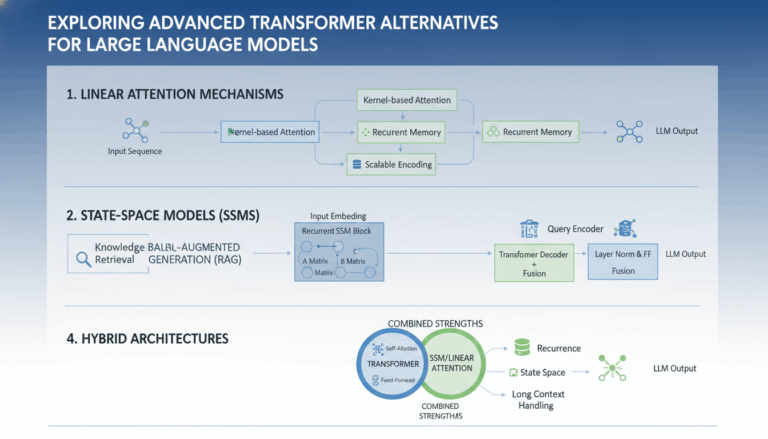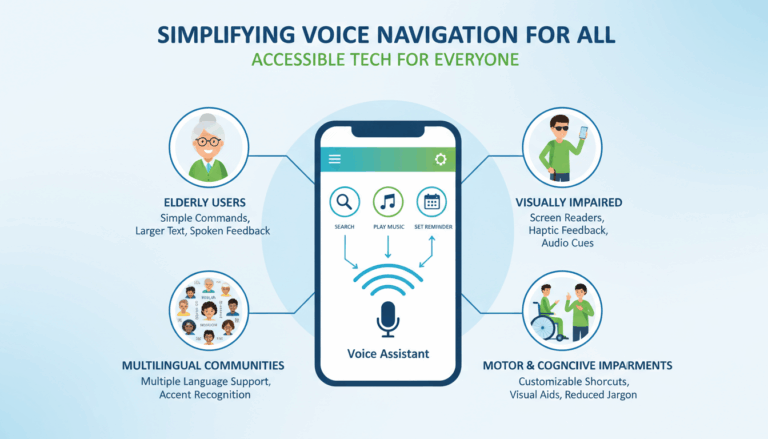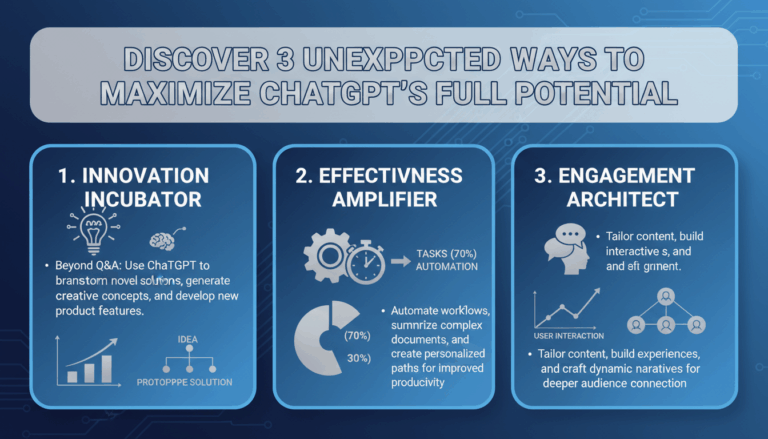Introduction to Recursive Reasoning in AI
Artificial Intelligence (AI) has seen a plethora of advancements over the years, with recursive reasoning emerging as a distinctive paradigm in the quest for creating more sophisticated AI systems. Recursive reasoning involves the AI continuously analyzing and refining its reasoning processes by referencing its previous outcomes or calculations. This loop of feedback allows systems to deepen their understanding and improve decision-making over time.
At its core, recursive reasoning mimics the way humans build on past knowledge to solve increasingly complex problems. This reasoning style is vital for developing AI that can handle tasks traditionally considered too intricate for machines. The idea is to enable machines to “think” in layers, processing information in successive cycles that improve upon earlier iterations.
One significant area where recursive reasoning shows promise is natural language processing (NLP). Recursive reasoning in AI enables language models to evaluate the context of phrases more accurately by considering not only the immediate sentence but also the broader discourse history. For example, when interpreting an ambiguous word in a sentence, a language model can recursively analyze previous sentences to determine the word’s most likely meaning.
Implementing recursive reasoning requires intricate algorithms, typically involving neural networks or other forms of machine learning models. These systems are developed to learn and improve through feedback loops. A popular technique is reinforcement learning, where an AI system is trained via a system of rewards and penalties, encouraging desired behaviors. By simulating environments where recursive reasoning can be applied—like strategic games or simulated negotiations—AI systems learn to predict outcomes by cycling through possible scenarios, continuously refining their strategies.
Practical applications of recursive reasoning extend beyond theoretical examples. Consider autonomous vehicles, which must understand real-time dynamics, predict future movements of surrounding entities, and react accordingly—all in rapid succession. Recursive reasoning allows these systems to improve their navigation decisions continually, adapting to new traffic patterns or unexpected events based on accumulating experience.
The recursive approach also aids in the enhancement of AI ethics and safety. By repeatedly validating reasoning processes against a set of ethical parameters, AI systems can adjust and align themselves to predefined moral guidelines. This is particularly pertinent as AI takes on more societally impactful roles.
As the world moves towards more integrated AI systems, recursive reasoning stands out as a pivotal development. By empowering AI with the ability to reflect on its learning processes, recursive reasoning not only advances technical capabilities but also pushes the boundaries of what machines can achieve. This continuous cycle of learning and improvement is a cornerstone of making AI more human-like in its processing and decision-making abilities.
Historical Context and Evolution of AI Training Paradigms
The trajectory of artificial intelligence (AI) training paradigms has undergone a dramatic evolution over the decades, shaped by the interplay of technological advancement, theoretical breakthroughs, and application demands. This journey can be divided into several pivotal eras, each contributing distinct methodologies and philosophies that paved the way for modern AI, including the recent turn towards recursive reasoning.
Initially, AI’s foundation was grounded in symbolic AI or “Good Old-Fashioned AI” (GOFAI), popularized during the mid-20th century. This approach hinged on predefined rules and logical structures designed to mimic human reasoning. Here, AI systems operated on hand-crafted knowledge bases and deterministic rule engines. Early success in tasks like simple logical puzzles spurred optimism; however, the rigidity of these systems proved inadequate for handling real-world complexity and uncertainty.
The limitations of symbolic AI gave rise to the connectionist revolution in the 1980s, epitomized by the resurgence of neural networks. These fresh paradigms embraced learning from data, exhibiting enhanced adaptability and scalability. Inspired by biological neural pathways, artificial neural networks (ANNs) marked a fundamental shift towards a more biologically plausible model of computation. Connectionism opened the door to supervised learning, allowing machines to learn representations from labeled input-output pairs. However, issues like overfitting and computational constraints initially kept neural networks from reaching their full potential.
By the late 1990s and early 2000s, the introduction of kernel methods and support vector machines (SVMs) offered robust algorithmic solutions for classification and regression problems. These methods were especially advantageous in dealing with high-dimensional data, operating effectively even with limited examples by maximizing the margin of separation between different classes.
A renaissance in AI training paradigms began in the late 2000s with the advent of deep learning. Fueled by increased computational power, access to big data, and innovations like the backpropagation algorithm, deep neural networks (DNNs) demonstrated unprecedented efficacy across diverse domains, from image recognition to natural language processing. This transformation was catalyzed by frameworks such as convolutional neural networks (CNNs) and recurrent neural networks (RNNs), which could capture spatial hierarchies and temporal dependencies in data, respectively.
As the sophistication of AI systems grew, attention turned to reinforcement learning (RL). Unlike previous paradigms that primarily learned from static datasets, RL trained agents to make sequential decisions by interacting with dynamic environments. This approach was instrumental in breakthroughs such as AlphaGo, where recursive reasoning via Monte Carlo Tree Search and deep Q-networks enabled strategic learning beyond fixed rules.
The current landscape of AI training continues to advance, with recursive reasoning standing out as a novel paradigm for crafting AI systems with deeper cognitive abilities. Rooted in iteratively refining reasoning through feedback loops, recursive models exemplify modern techniques that learn to optimize their logic by considering historical decision paths. This recursive approach not only provides a mechanism for continuous learning but also holds the promise of achieving human-like adaptability and intuition in decision making.
Furthermore, the movement towards incorporating ethical and explainable AI within training paradigms reflects an evolving awareness of the broader implications of AI deployment. Systems trained with recursive reasoning are increasingly aligned with ethical standards, adapting to societal needs by refining their decision criteria based on historical ethical evaluations.
Today’s AI training paradigms are a melange of foundational principles and cutting-edge innovations. They represent an amalgamation of historical wisdom and frontier advancements, culminating in approaches like recursive reasoning that aim to bring about a profound shift in how AI perceives and interacts with the world.
Fundamentals of Recursive Reasoning
Recursive reasoning in artificial intelligence (AI) involves an iterative loop of processing, where each cycle refines and improves the outputs of previous iterations. This process is central to mimicking human-like reasoning in machines, fostering both adaptability and enhanced problem-solving capabilities. At its heart, recursive reasoning allows AI systems to analyze the outcomes of their computational processes, adjust their strategies based on past performance, and continuously refine their decision-making logic.
Central to understanding recursive reasoning is the notion of a feedback loop. In this model, the AI system not only generates a solution based on current data but also evaluates the effectiveness of this solution by comparing it with historical data or expected results. This comparison forms a basis for modifying the AI’s parameters, helping refine future calculations or predictions. This iterative refinement ensures learning that builds in complexity over time, akin to human experiential learning.
To illustrate, consider a chess-playing AI utilizing recursive reasoning. Initially, the AI evaluates a broad array of potential moves based on immediate board conditions. It then develops strategies by observing outcomes of simulated games or through interaction with human players. As it accumulates experience, it iteratively refines its heuristic evaluations and decision trees, learning to anticipate opponent moves and strategize several steps ahead. The recursive aspect lies in this continual reassessment and adjustment process, enabling the system to develop increasingly sophisticated, robust strategies.
The design of systems leveraging recursive reasoning often involves complex algorithms. A pivotal approach used is reinforcement learning (RL), where the AI agent learns within an environment through trial and error. Feedback loops in RL are critical, where rewards or penalties are assigned to specific actions, guiding the learning process. Over time, the AI refines its strategy to maximize cumulative rewards, dynamically adjusting its approach based on past successes or failures.
Moreover, recursive reasoning facilitates enhanced interpretability and predictability in AI systems. A practical application is in natural language processing (NLP), where recursive reasoning models can determine the context of ambiguous sentences by reviewing and incorporating preceding text for holistic understanding. This recursive context analysis improves the capacity of language models, enabling more coherent and sensible language interactions.
Ethically, recursive reasoning enhances the ability of AI systems to align with human values and ethical standards through continuous recalibration based on accumulated ethical decision-making data. As systems refine their reasoning processes, they can become more attuned to ethical guidelines, ensuring decisions are increasingly aligned with societal norms.
Overall, recursive reasoning represents a foundational step towards more intelligent, adaptable AI systems. By emulating human-like cognitive processes through feedback loops and iterative learning strategies, AI becomes capable of tackling complex, nuanced problems that require depth beyond surface-level analysis.
Implementing Recursive Reasoning in AI Models
Implementing recursive reasoning in AI models involves a structured approach, primarily focusing on integrating iterative feedback loops that refine decision-making processes over time. This requires careful consideration of the algorithms and frameworks used, as well as thorough preparation of the training environment to simulate dynamic scenarios effectively.
The first step in implementing recursive reasoning is selecting a suitable framework or library that supports iterative learning. Popular frameworks such as TensorFlow and PyTorch have built-in support for recursive functions, enabling developers to construct models that can easily incorporate feedback loops. These tools provide flexibility in designing custom layers and operations that are crucial for recursive processes.
Next, developers need to define the architecture of the neural network. This involves deciding on the type of network (e.g., convolutional, recurrent, or a hybrid approach) based on the problem domain. For instance, recurrent neural networks (RNNs) are particularly suitable for tasks requiring sequence prediction due to their inherent architecture that supports temporal data processing. Implementing recursive reasoning in such networks involves setting up mechanisms like gated recurrent units (GRUs) or long short-term memory (LSTM) cells, which help preserve information across sequences while adjusting based on previous outputs.
When constructing recursive networks, it is vital to incorporate a feedback loop mechanism. This can be achieved by designing recursive functions that take outputs from previous iterations as inputs for subsequent rounds. Such recursive functions enable the model to evaluate its past decisions and adjust its parameters accordingly. For example, in a game-playing AI, the model might simulate multiple potential future moves, using the results of these simulations to update its strategy dynamically.
Another crucial aspect is setting up a reward system if reinforcement learning (RL) is used. In RL, recursive reasoning can be implemented by allowing the AI to interact with its environment, receive rewards or penalties for actions, and use this feedback to refine its strategy. Creating a simulated environment with well-defined rules and scenarios is essential. For example, in autonomous driving simulations, the system could be encouraged to optimize for safety and efficiency by learning from consequences in diverse traffic situations.
During the implementation phase, it’s important to conduct extensive training using large datasets to ensure the recursive model gathers a wide range of experiences. This often involves running multiple epochs and carefully tuning hyperparameters to achieve optimal performance. Techniques such as backpropagation through time (BPTT) may be employed to handle gradient updates within recursive frameworks, allowing the model to effectively learn from past mistakes and successes.
Finally, testing and validation are critical to ensure that recursive reasoning is correctly implemented and that the AI exhibits improved adaptability and effectiveness over time. This includes monitoring the model’s performance in various unseen environments and adjusting its learning parameters based on ongoing feedback. Employing methods such as k-fold cross-validation can help verify the generalization capabilities of the recursive model, ensuring it performs well not only on training data but also in real-world applications.
Implementing recursive reasoning in AI models is a complex but rewarding effort, involving careful planning, robust architecture design, and thorough testing. By successfully embedding these recursive processes, AI systems can achieve a level of adaptability and nuance previously unattainable, pushing the boundaries of what artificial intelligence can accomplish.
Case Studies: Applications of Recursive Reasoning in AI
The utility of recursive reasoning in artificial intelligence (AI) can be best understood through various case studies that highlight its applications across multiple domains. These studies not only demonstrate the power of recursive processes but also illustrate how they’re implemented to solve complex, real-world problems.
Consider the realm of natural language processing (NLP), where recursive reasoning is pivotal in developing more coherent and contextually aware AI systems. An exemplary case is that of language translation software, like Google Translate, which uses recursive neural networks (RNNs) to parse and translate text. By employing recursive reasoning, these systems can analyze previous sentences within a document to better understand nuances and maintain context across translations. This iterative process enables the model to handle ambiguous phrases more effectively and produce translations that are coherent and contextually accurate.
In the domain of autonomous vehicles, recursive reasoning underpins the decision-making capabilities required for real-time navigation. Companies like Tesla and Waymo have integrated recursive feedback mechanisms into their vehicles’ systems to continuously improve their decision-making processes. For instance, recursive reasoning allows these vehicles to predict traffic patterns by analyzing data from multiple sensors over time, iteratively refining their predictions based on new inputs. This capability ensures that the vehicle can adjust its path dynamically, responding to unforeseen obstacles and rapidly changing traffic conditions.
A noteworthy example in strategic game playing is the development of AlphaZero by DeepMind. This AI system utilizes recursive reasoning by relying on Monte Carlo tree search (MCTS) combined with deep learning to evaluate numerous potential future moves in games like chess and Go. Through recursive exploration of the game tree, AlphaZero refines its understanding of optimal strategies by simulating countless scenarios and adjusting its approach based on the outcomes. This process of continuous self-play and recursive learning enables AlphaZero to achieve superhuman levels of play by progressively enhancing its strategy without any explicit domain-specific knowledge.
In medical diagnostics, recursive reasoning facilitates improved diagnostic accuracy and treatment planning. AI systems designed to assist in medical imaging analysis, such as those developed by Zebra Medical Vision, use recursive neural networks to iteratively analyze images from various perspectives. This approach helps in identifying patterns and anomalies that might be missed in a single pass. By recursively adjusting diagnostic criteria based on a wealth of past cases, these systems improve both the speed and accuracy of disease detection.
Furthermore, recursive reasoning plays a crucial role in financial forecasting and risk assessment models. AI systems in this sector, such as those developed by firms like Kensho, use recursive algorithms to evaluate economic indicators and market signals over time. By continually reassessing predictions against real-world outcomes, these systems enhance their forecasting accuracy, allowing for better-informed investment strategies and risk mitigation.
The application of recursive reasoning in AI is not limited to these sectors alone. Its versatility and effectiveness in handling dynamic, unpredictable environments make it a crucial tool in various fields. By iterating upon past experiences and refining strategies contextually, recursive reasoning empowers AI systems to accomplish tasks with a level of sophistication akin to human reasoning, laying the groundwork for future advancements in AI technology.
Challenges and Future Directions in Recursive Reasoning
Recursive reasoning in AI poses considerable challenges, mainly due to the computational and conceptual complexity it entails. These challenges include designing efficient algorithms capable of handling extensive feedback loops, managing the substantial resource demands of iterative operations, and ensuring interpretable outcomes from recursive processes.
One significant challenge is the efficient implementation of recursive algorithms, which can be resource-intensive. Recursive reasoning involves continuous processing and recalibration of data through feedback mechanisms, leading to increased computational load. Handling this effectively requires optimized algorithms that can manage large volumes of data in real-time, particularly in dynamic environments like autonomous driving or real-time strategic gaming.
Moreover, recursive systems necessitate robust architectures that prevent issues such as vanishing gradients, common in deep learning models like recurrent neural networks (RNNs). Advanced architectures, including Long Short-Term Memory (LSTM) or Gated Recurrent Units (GRU), are utilized to mitigate these issues, allowing the systems to maintain the integrity of feedback over long sequences. Ensuring these models scale effectively as the complexity of tasks increases is an ongoing area of research.
Interpreting recursive reasoning models presents another challenge. As AI systems become more complex, understanding the rationale behind their decisions becomes harder. This poses problems in applications where transparency and accountability are critical, such as healthcare and financial services. Developing explainable AI techniques that can unpack the layers of recursive reasoning is essential for gaining user trust and meeting regulatory demands.
Data quality and the availability of diverse datasets also impact recursive learning. Systems trained on biased or incomplete data may reach flawed conclusions, undermining performance. Ensuring datasets accurately represent real-world variability is necessary for building reliable recursive systems. Researchers are exploring methodologies to automatically detect and correct biases in data, thus enhancing the robustness of AI outcomes.
Looking to the future, integrating recursive reasoning with advances in quantum computing holds promise for overcoming current computational limitations. Quantum algorithms, with their ability to process large-scale data sets simultaneously, could significantly accelerate recursive computations, opening new possibilities in domains requiring high-speed processing.
Additionally, enhancing model generalization through meta-learning represents a key direction for future development. By training models to adaptively learn recursive strategies across varying tasks, researchers aim to create AI that can transfer knowledge more effectively, achieving human-like flexibility in reasoning.
As AI systems continue to evolve, the ethical implications associated with recursive reasoning are gaining attention. Ensuring AI systems adhere to ethical guidelines as they recursively adjust their decision frameworks is increasingly important. This involves embedding ethical reasoning capabilities and constantly updating these frameworks to align with societal norms, maximizing the societal benefit of advancing AI technologies.
Overall, addressing these challenges and exploring future directions in recursive reasoning are crucial steps towards realizing its full potential. By overcoming technical barriers, ensuring interpretability, and refining ethical considerations, recursive reasoning can become a cornerstone of next-generation AI, empowering machines with advanced cognitive capabilities akin to human reasoning.



